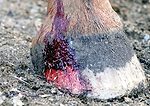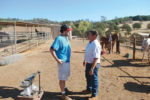Advertise Follow Us
Articles Tagged with ''abscess''
Shoeing for a Living
Kirk Smith enjoys the challenge of balancing the horse’s system of levers and pulleys
Read More
Red Flags For Farriers
Warning Signs That Mean It’s Time to Call the Vet
The ability to spot potential trouble signs will improve your professional image and will be appreciated by good clients
Read More
Hoof-Care Focus
Dealing with Wounds on Horses' Feet
Fast and accurate assessment often required
Read More
Vet and Farrier Team Tackles Keratoma
In a case with a rescue horse, recurrent lameness, abscess and hoof wall defects are secondary to keratoma
Read More
Product Knowledge
Abscess Kit Makes for Easier Treatment
All-in-one package found farrier, horse-owner friendly.
Read More









